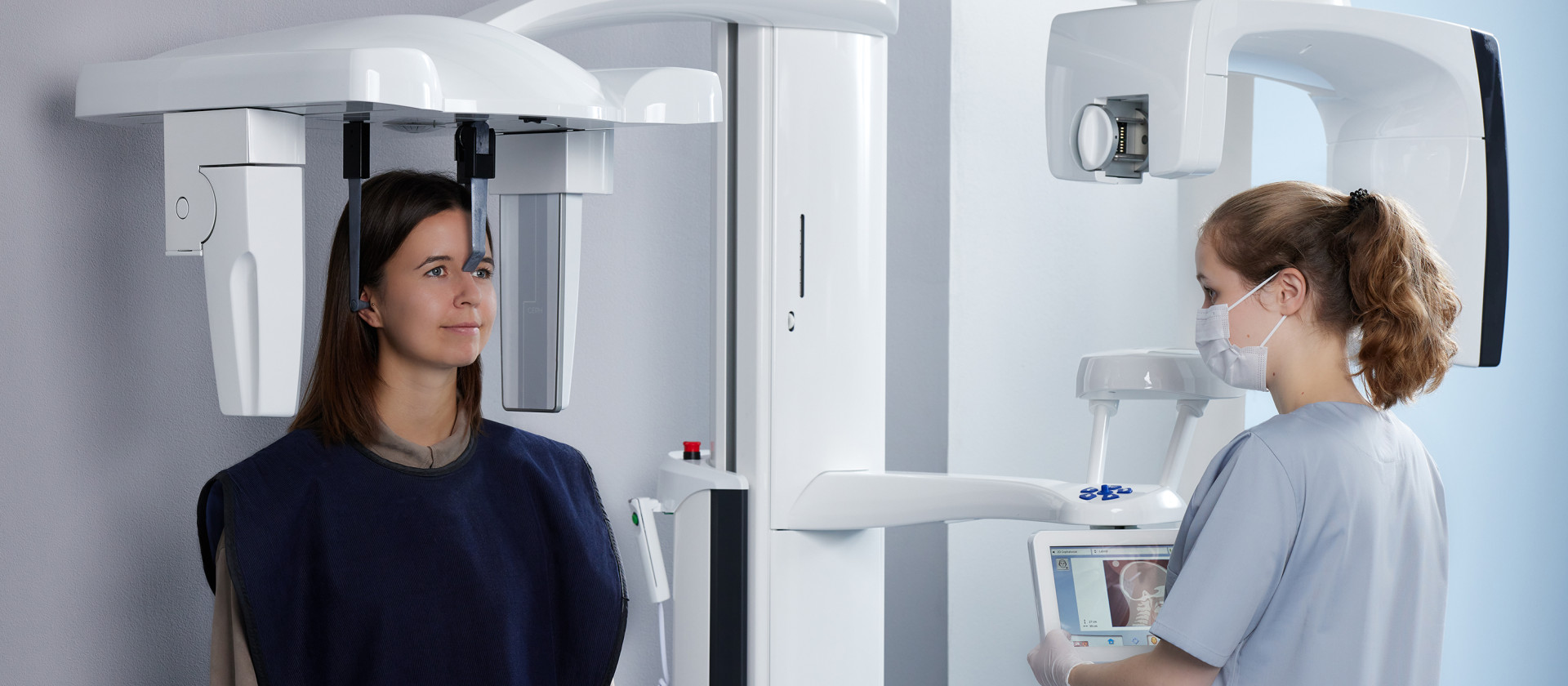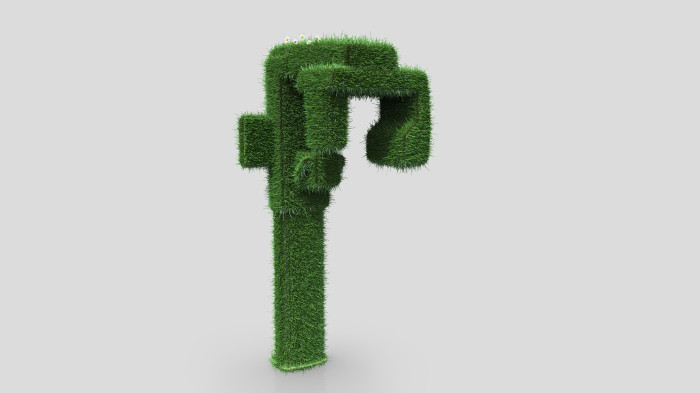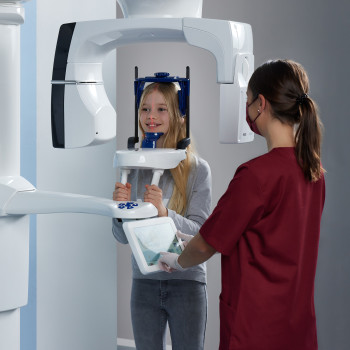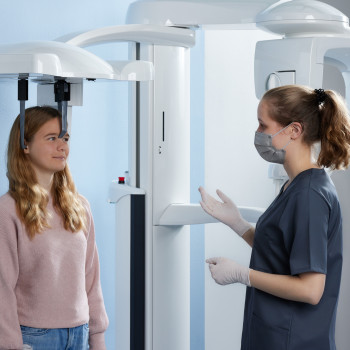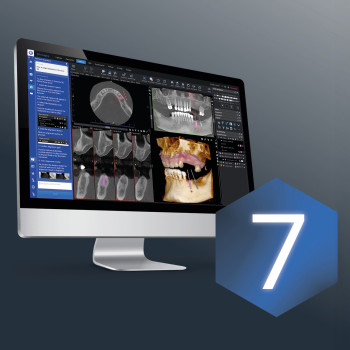- Comfortable face-to-face patient positioning
- Compact and space-saving design
- Patented SCARA (Selectively Compliant Articulated Robot Arm) technology for anatomically correct image geometry
- Easy-to-use touch display with a variety of practical presettings
- Time-based efficiencies in the digital process thanks to the Romexis all-in-one software
- Possibility of expansion with the cephalometric device
The KaVo ProXam 2D series was developed to best meet the multitude of diagnostic needs in the dental practice: whether panoramic, extraoral bitewing, temporomandibular joint or sinus images, the KaVo ProXam 2D offers versatile extraoral X-ray imaging of the highest standard in terms of image quality
and ease of use.
KaVo ProXam 2D - Demo Video
KaVo ProXam Imaging Portfolio
The use of innovative technology at KaVo follows a clear goal: it must add real value in everyday practice. The KaVo ProXam 2D series meets this requirement in every respect and operation is simplified thanks to its numerous, automated presets and a multitude of smart support functions. The 2D image results are also impressive, with high, 16-pixel resolution and a compelling level of detail.
The robot -supported 2-joint arm with SCARA (Selectively Compliant Articulated Robot Arm) technology also ensures anatomically perfect image geometry from high-precision movements.
The KaVo ProXam 2D X-ray units offer a wide range of extraoral imaging methods:
- Panoramic shots
- Ceph imaging
- Extraoral bitewings
- TMJ recordings
- Sinus imaging
- Child mode available for all procedures mentioned
- Dynamic exposure control for panoramic and cephalometric X-rays
The SCARA-3 technology of the ProXam 2D Pro makes further exclusive special functions possible:
Extended panorama programs:
- Interproximal panoramic program
- Orthogonal panoramic program
- Lateral and linear sinus program
- Three-angle posterior/anterior TMG program
- Autofocus:
- Scout image for optimal patient positioning
- Cephalometric ProCeph, one-shot
The perfect symbiosis of simple operation and high image quality.
The KaVo ProXam 2D series can be controlled using the desktop software on the PC or via the adjustable touch display panel on the unit - another userfriendly feature.
Operating the touch display is simple and intuitive: the most recently used modes are displayed on the start screen, allowing the user to quickly select the desired X-ray programme.
After selecting the programme, the step-by-step instructions guide you through the entire X-ray workflow.
The KaVo ProXam 2D & 2D Pro also offer a number of advantages for patient comfort: thanks to the spacious, vertical range of motion, it is easy and convenient to take pictures of particularly tall patients as well as of children or wheelchair users.
The open architecture allows for comfortable face-to-face patient positioning, which is a useful feature to reassure anxious patients. For easy orientation, the patient's position is shown on the touch display.
The sagittal plane, the Frankfurt horizontal plane and the focus layer are projected via the triple laser system.
In addition to the standard panorama programme, there are other programmes to choose from:
- Bitewing
- Temporomandibular joint
- Sinus
- Optional Ceph imaging for all orthodontic needs
A special highlight: the KaVo ProXam 2D extraoral bitewing imaging programme offers an improved interproximal angulation geometry, which ensures more precise images of the bitewing with low radiation exposure.
To reduce the radiation dose, the exposure area can be focused on the diagnostic target area with the KaVo ProXam 2D series using the optional "Horizontal and vertical segmentation" programme.
Compared to the full panoramic exposure, the radiation dose is reduced by up to 90%.
To protect the smallest patients, the KaVo ProXam 2D offers a special children's mode within each programme, in which the image area and the exposure times are reduced, thus minimising the radiation dose from the outset. This children's mode is automatically activated as soon as the smallest patient size is selected in the respective programme. As soon as the respective settings have been made, the KaVo ProXam 2D X-ray unit automatically adjusts all exposure parameters and the kV and mA exposure values can then be readjusted manually.
Early in the design process, priority was given to developing a compact, space-saving unit.
The KaVo ProXam 2D impresses users not only with its timeless and attractive design, but also with material and processing quality that stands the test of time.
- The patented SCARA (Selectively Compliant Articulated Robot Arm) technology ensures anatomically correct image geometry.
- Easy-to-use touch display with a variety of practical presettings.
- Fully integrated into the Romexis all-in-one software for additional time savings in the digital process.
- More flexibility with the ability to expand to the cephalometric unit.
Technical Specifications
Microprocessor-controlled resonance mode generator with constant potential:
- Very high operating frequency 80–150 kHz (resonant mode)
- Maximum residual ripple 670 Vpp (0.4% 84 kV)
- Ultra short rise time, < 3 ms
- Very wide range of exposure parameters, 1–16 mA / 60–84 kV
- Low patient dose
- Universal power input
- Mains voltage fluctuations are automatically compensated
Reliable mechanical construction
- Small size and light weight, total weight 113 kg
- Unique 2-joint- (ProXam 2D) resp. 3-joint- (ProXam 2D Pro) SCARA (Selectively Compliant Articulated Robot Arm) technology
- Telescopic column without counterweight. Maximum height adjustable.
- Automatic primary collimator with four leaves
- Available as wall mounted or free standing
KaVo ProXam 2D & 2D Pro in comparison:
| KaVo ProXam 2D | KaVo ProXam 2D Pro | |
|---|---|---|
| SCARA2 Technology | | |
| SCARA3 Technology | | |
| Panoramic recording | | |
| Horizontal and vertical segmentation | (optional) | (optional) |
| Bitewing Panorama Program | (optional) | (optional) |
| Advanced panorama programs | (optional) | |
| Dynamic exposure control | (optional) | (optional) |
| Cephalometric option, scanning | (optional) | (optional) |
| KaVo ProCeph cephalometric option, one-shot | (optional) |
Sensor system:
- One interchangeable sensor for panoramic and cephalometric images or two fixed sensors
- Easily and quickly switch between imaging modes
- Very small and adjustable pixel size, high-resolution imaging, minimised motion blur
- Highly sensitive detection -> low dose of radiation
- Automatic Gain Control (AGC) optimises the sensitivity of the digital sensor to achieve excellent image quality (regardless of patient tissue and bone thickness)
- Dental Image Contrast Enhancement (DICE) automatically optimises the image contrast and exposes image details throughout the grey scale
- Fast Ethernet connection to the computer
- Radiation hardened long-life sensor
Ceph (optional):
- Stable construction
- Automatic alignment of the radiation source
- Clever design with user-friendly head positioning, pivoting nose pad, low-absorption carbon fibre ear plugs
- No mechanical soft tissue filter, soft tissue filter in imaging software
- Image size from 18 x 18 cm to 30 x 27 cm
- All projections possible: lateral, AP/PA, oblique, submental apex, Waters', AP Towne, Hand & Wrist
Cephalometric ProCeph, one-shot (optional)
- No motion artifacts due to the short exposure time
- Maximum image size 30x25 cm
- The head positioning aid and the carbon fiber nose clip are radiolucent, particularly stable and hygienic
- The device aligns itself automatically and selects the appropriate collimator
- Special collimation options for pediatric imaging
- Only possible with ProXam 2D Pro and 3D imaging devices
| The maximum height is adjustable | |
|---|---|
| Weight | 119 kg (3D unit) 26 kg (Ceph) |
| Chin rest level | 96 – 178 cm |
| Ceph ear pad height | 97 – 179 cm |
Accessories:
2D Quart Test Phantom Set
Mat. No.: 2.023.4050
Wall switch EU
Mat. No.: 2.023.1051
Manual x-ray support
Mat. No.: 2.023.4052
Additional wall mount bracket
For two-point wall mount
Mat. No.: 2.023.4053
